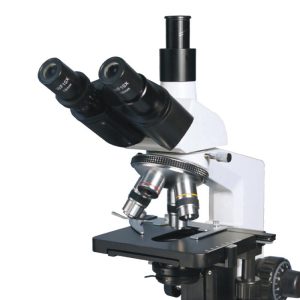シリンダーと接眼レンズ: 顕微鏡の正確な構造と機能
顕微鏡の複雑な世界, the cylinder and eyepiece are difficult or absent elements that work together to enable us to observe tiny biological and material structures in depth. This article will introduce the functions and types of eyepiece and cylinder, and their role in the microscope.

シリンダーと接眼レンズ: 顕微鏡の正確な構造と機能
The function of eyepiece:
The eyepiece is usually located at the top of the microscope, and its role is to further enlarge the image after the objective lens is enlarged, so that the human eye can clearly observe the specimen. The eyepiece is divided into two working modes: monocular and binocular.
Monocular eyepiece: This is a traditional way of working with eyepieces, but is now rarely used. It has only one lens and the observer observes the specimen with one eye.
Binocular goggles: Binocular goggles are the more common way of working. It has two lenses called the field mirror and the eyepiece. This design allows the observer to observe the specimen using both eyes, simulating the natural observation environment and reducing eye strain.
Modern eyepieces usually employ compound lenses to correct optical defects such as magnification chromatic aberration, coma, and aberration. The design of the field mirror and eyepiece allows the observer to obtain high quality microscopic images.
シリンダーと接眼レンズ: 顕微鏡の正確な構造と機能
Type of mirror cylinder:
The cylinder is the bottom part of the microscope, usually connected to the objective lens, and can be divided into three types: monocular, binocular, and trinary.
Monocular cylinder: This type of cylinder has become less used. It allows the observer to observe the specimen using only one eye and is less suitable for applications that require in-depth observation and recording of microscopic structures.
Binocular barrel: Binocular barrel is the common type. It allows both eyes to observe the specimen simultaneously, providing a more natural and comfortable viewing experience. 通常, binocular cartridges have adjustable pupil distance and telescopic range to accommodate different observers.
Triocular tube: Triocular tube is commonly used for photomicrography needs. It allows the observer to view the specimen using both eyes, while also having an additional optical channel that can be connected to a camera device to take high-quality micrographs and videos.
シリンダーと接眼レンズ: 顕微鏡の正確な構造と機能
The Importance of cylinder and eyepiece:
The cylinder and eyepiece are important parts of the microscope, and their design and quality directly affect the observation effect and comfort. Binocular cartridges and high-quality eyepieces allow the observer to view the specimen more easily, reduce eye strain, and obtain higher quality microscopic images. 同時に, the triocular tube facilitates microphotography, allowing scientists to record and share their findings.
要約すれば, the cylinder and eyepiece play a crucial role in microscopy, and their precise design and working mode provide a better viewing experience and high-quality microscopic observation results. These key components allow scientists to delve deeper into the microscopic world and reveal its mysteries. The mirror tube and the eyepiece together form the window of the microscopic world.
